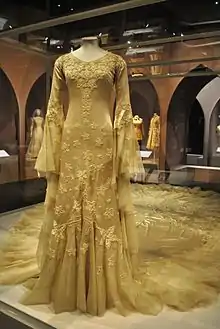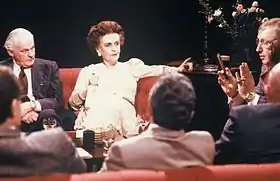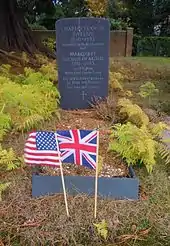Margaret Campbell, Duchess of Argyll
Ethel Margaret Campbell, Duchess of Argyll (née Whigham; 1 December 1912 – 25 July 1993) was a British socialite, best remembered for a celebrated divorce case in 1963[1] from her second husband, the 11th Duke of Argyll, which featured salacious photographs and scandalous stories.[2]
The Duchess of Argyll | |
|---|---|
 | |
| Born | Ethel Margaret Whigham 1 December 1912 Newton Mearns, Renfrewshire, Scotland |
| Died | 25 July 1993 (aged 80) |
| Resting place | Brookwood Cemetery, Surrey, England |
| Spouse(s) | Charles Francis Sweeny
(m. 1933; div. 1947) |
| Children | 3, including Frances Manners, Duchess of Rutland |
| Parent(s) | George Hay Whigham Helen Mann Hannay |
Birth and youth
Margaret was the only child of Helen Mann Hannay and George Hay Whigham, a Scottish millionaire who was chairman of the Celanese Corporation of Britain and North America. She spent the first 14 years of her life in New York City, where she was educated privately at the Hewitt School. Her beauty was much spoken of, and she had youthful romances with playboy Prince Aly Khan, millionaire aviator Glen Kidston, car salesman Baron Martin Stillman von Brabus and publishing heir Max Aitken.[3]
In 1928, David Niven, then 18, had sex with the 15-year-old Margaret Whigham, during a holiday at Bembridge on the Isle of Wight. To the fury of her father, she became pregnant as a result. Margaret was rushed into a London nursing home for a secret termination. "All hell broke loose," remembered her family cook, Elizabeth Duckworth. Margaret didn't mention the episode in her 1975 memoirs, but she continued to adore Niven until the day he died. She was among the VIP guests at his London memorial service.[4]
In 1930, she was presented at Court in London and was known as the deb (or debutante) of that year. Shortly afterwards, she announced her engagement to Charles Guy Fulke Greville, 7th Earl of Warwick.[1] However, the wedding did not take place, for her head had been turned by Charles Sweeny, an American amateur golfer from a wealthy Pennsylvania family.[1] Her numerous early romantic escapades included an affair with the married Prince George, Duke of Kent.[5]
First marriage

On 21 February 1933, and after converting to his Roman Catholic faith,[3] Margaret married Charles Francis Sweeny (1910–1993) at the Brompton Oratory, London.[6] Such had been the publicity surrounding her Norman Hartnell wedding dress, that the traffic in Knightsbridge was blocked for three hours.[7] For the rest of her life, she was associated with glamour and elegance, being a firm client of both Hartnell and Victor Stiebel in London before and after the war. She had three children with Charles Francis Sweeny: a daughter, who was stillborn at eight months in late 1933; another daughter, Frances Helen (born 1937, she married Charles Manners, 10th Duke of Rutland), and a son, Brian Charles (born 1940). The Sweenys divorced in 1947.[1]
In 1943, Margaret Sweeny had a near fatal fall down a lift shaft while visiting her chiropodist on Bond Street. "I fell forty feet to the bottom of the lift shaft", she later recalled. "The only thing that saved me was the lift cable, which broke my fall. I must have clutched at it, for it was later found that all my finger nails were torn off. I apparently fell on to my knees and cracked the back of my head against the wall".[3]
Intermarital romances
After the end of her first marriage, Margaret was briefly engaged to a Texas-born banker, Joseph Thomas, of Lehman Brothers, but he fell in love with another woman and the engagement was broken. She also had a serious romantic relationship with Theodore Rousseau, curator of the Metropolitan Museum of Art who was, she recalled "highly intelligent, witty and self-confident to the point of arrogance". That romance also ended without the couple formalising their liaison, since the mother of two "feared that Ted was not 'stepfather material'".[3] Still, she noted in her memoirs, "[W]e continued to see each other constantly."[3] She once reportedly said, "Go to bed early and often".[8]
Second marriage
On 22 March 1951, Margaret became the third wife of Ian Douglas Campbell, 11th Duke of Argyll. She wrote later in life:
I had wealth, I had good looks. As a young woman I had been constantly photographed, written about, flattered, admired, included in the Ten Best-Dressed Women in the World list, and mentioned by Cole Porter in the words of his hit song "You're the Top". The top was what I was supposed to be. I had become a duchess and mistress of an historic castle. My daughter had married a duke. Life was apparently roses all the way.[3]
(She was not mentioned in the original version of the song. P. G. Wodehouse anglicised it for the British version of Anything Goes, changing two lines from "You’re an O’Neill drama / You’re Whistler’s mama!" to "You’re Mussolini / You’re Mrs Sweeny")[9][10]
Divorce from the Duke of Argyll
Within a few years, the marriage was falling apart. The Duke suspected his wife of infidelity and, while she was in New York, he employed a locksmith to break open a cupboard at their Mayfair home, 48 Upper Grosvenor Street. The evidence discovered resulted in the 1963 divorce case, in which the Duke of Argyll accused his wife of infidelity and included a set of Polaroid photographs of the Duchess nude, save for her signature three-strand pearl necklace, in the company of another man. There were also photographs of the bepearled Duchess fellating a naked man whose face was not shown. It was speculated that the "headless man" was the Minister of Defence Duncan Sandys (later Lord Duncan-Sandys, son-in-law of Winston Churchill), who offered to resign from the cabinet.[11]
Also introduced to the court was a list of as many as 88 men with whom the Duke believed his wife had consorted; the list is said to include two government ministers and three members of the British royal family. The judge commented that the Duchess had indulged in "disgusting sexual activities". Lord Denning was called upon by the government to track down the "headless man." He compared the handwriting of the five leading "suspects" (Duncan-Sandys; Douglas Fairbanks, Jr.; John Cohane, an American businessman; Peter Combe, a former press officer at the Savoy Hotel; and Sigismund von Braun, brother of the German scientist Wernher von Braun) with the captions written on the photographs.[11] It is claimed that this analysis proved that the man in question was Fairbanks, then long-married to his second wife; but this was not made public.[12] Granting the divorce, Lord Wheatley, the presiding judge, said the evidence established that the Duchess of Argyll "was a completely promiscuous woman whose sexual appetite could only be satisfied with a number of men".[5]
The Duchess never revealed the identity of the "headless man", and Fairbanks denied the allegation to his grave. Long afterward, it was claimed that there were actually two "headless men" in the photographs, Fairbanks and Sandys, the latter identified on the basis of the Duchess's statement that "the only Polaroid camera in the country at that time had been lent to the Ministry of Defence".[11]
The Duke of Argyll married an American, Mathilda Coster Mortimer Heller, in 1963, and died of a stroke, in 1973, aged 69.[13]
Final years
Margaret wrote a memoir, Forget Not, which was published by W. H. Allen Ltd in 1975 and negatively reviewed for its name dropping and air of entitlement. She also lent her name as author to a guide to entertaining. Her fortune diminished, however, and she eventually opened her London house—48 Upper Grosvenor Street, which had been decorated for her parents in 1935 by Syrie Maugham[14] — for paid tours. Even so, her extravagant lifestyle and ill-considered investments left her largely penniless by the time she died.[15]

In 1978, her debts forced Margaret to move from Upper Grosvenor Street and relocate with her maid to a suite at the Grosvenor House Hotel.[16]
In April 1988, on the evening after the Grand National, she appeared on a Channel 4 After Dark discussion about horseracing "so she said, to put the point of view of the horse", later walking out of the programme "because she was so very sleepy".[17]
In 1990, unable to pay the hotel bills, she was evicted, and with the support of friends and her first husband moved to an apartment.[18] Her children later placed her in a nursing home in Pimlico, London. She was photographed there by Tatler magazine, for which she had previously been a columnist, sitting on the edge of her bed in a grim single room. Margaret died in penury in 1993 after a bad fall in the nursing home. She was buried alongside her first husband, Charles Sweeny, in Brookwood Cemetery in Woking, Surrey.[19]
Personality

She once told The New York Times, "I don't think anybody has real style or class any more. Everyone's gotten old and fat." More to the point, she described herself as "always vain". Another quote gives an insight into her personality: "Always a poodle, only a poodle! That, and three strands of pearls!" she said. "Together they are absolutely the essential things in life."[20]
In popular culture
- Powder Her Face, a chamber opera based on major events in the Duchess's life, received its premiere at the Cheltenham Music Festival in 1995. The English composer Thomas Adès wrote the music, and novelist Philip Hensher contributed the libretto; the Festival, along with the Almeida Opera, commissioned the piece.[21] The opera's Duchess character, an image of the real woman refracted through an astringent camp sensibility, invites both sympathy and contempt for her by design.[22]
- Campbell's divorce will be dramatized in the second series of Amazon/BBC's A Very English Scandal, written by Sarah Phelps.[23][24]
References
- "The scarlet Duchess of Argyll: Much more than just a Highland fling". The Independent. Retrieved 12 January 2015.
- "The Argyll charade: The Journal Online". Journalonline.co.uk. Retrieved 12 January 2015.
- Campbell, Margaret (1975). Forget Not: The Autobiography of Margaret, Duchess of Argyll. W. H. Allen. ISBN 0-491-01825-8.
- Niv by Graham Lord, Orion, 2004, p. 420
- "The Dirty Duchess of Argyll was ahead of her time". The Times. 2 February 2019. Retrieved 2 February 2019.
- "Brilliant society wedding 1933". British Pathe News.
- "Chic Vintage Bride – Margaret Whigham". Chic Vintage Brides. Archived from the original on 30 July 2014.
- "Lipstick on her collar". The Independent. 30 June 1995. Retrieved 2 February 2019.
- "Mayfair, the Duchess of Argyll and the Headless Man polaroids « Another Nickel in the Machine". Nickelinthemachine.com. Retrieved 12 January 2015.
- Warren Hoge London Journal; A Sex Scandal of the 60's, Doubly Scandalous Now The New York Times 16 August 2000
- Sarah Hall (10 August 2000). "'Headless men' in sex scandal finally named". The Guardian. London. Retrieved 6 October 2008.
- Warren Hoge, "London Journal: A Sex Scandal of the '60s, Doubly Scandalous Now," The New York Times, 16 August 2000.
- "Eleventh Duke of Argyll, Chief of Campbells". The Glasgow Herald. 9 April 1973. p. 7. Retrieved 22 October 2017.
- "Upper Grosvenor Street: South Side Pages 231-238 Survey of London: Volume 40, the Grosvenor Estate in Mayfair, Part 2 (The Buildings). Originally published by London County Council, London, 1980". British History Online. Retrieved 13 July 2020.
- Terry Kirby (6 February 2004). "For sale: London residence where Duchess scandalised society". The Independent. Archived from the original on 24 November 2009. Retrieved 12 February 2013.
- "Obituary: Margaret Duchess of Argyll". The Telegraph. 28 July 1993. Retrieved 2 February 2019.
- Sebastian Cody (14 August 2007). "Tony Wilson - 'Britain's finest live presenter' | Media". London: MediaGuardian. Retrieved 6 October 2008.
- Randall, David (17 February 2013). "The scarlet Duchess of Argyll: Much more than just a Highland fling". The Independent. Retrieved 17 September 2018.
- "Margaret Campbell, Duchess of Argyll". The Androom Archives. Retrieved 2 February 2019.
- John Dukas, "Dukas' Diary: Advice from the Duchess", HG, October 1988, p. 160
- "Thomas Adès's Powder Her Face and the shocking power of the sex selfie". The Guardian. 27 March 2014. Retrieved 2 February 2019.
- O'Brien, Geoffrey (19 February 2013). "In My Lady's Crowded Chamber". The New York Review of Books. Retrieved 2 February 2019.
- Kanter, Jake (11 March 2020). "'The ABC Murders' Writer Sarah Phelps Signs Up For 'A Very English Scandal' Season 2".
- Association, Press (31 January 2019). "A Very English Scandal series 2 will focus on the 'Dirty Duchess' divorce case" – via www.telegraph.co.uk.
External links
| Wikimedia Commons has media related to Margaret Campbell, Duchess of Argyll. |